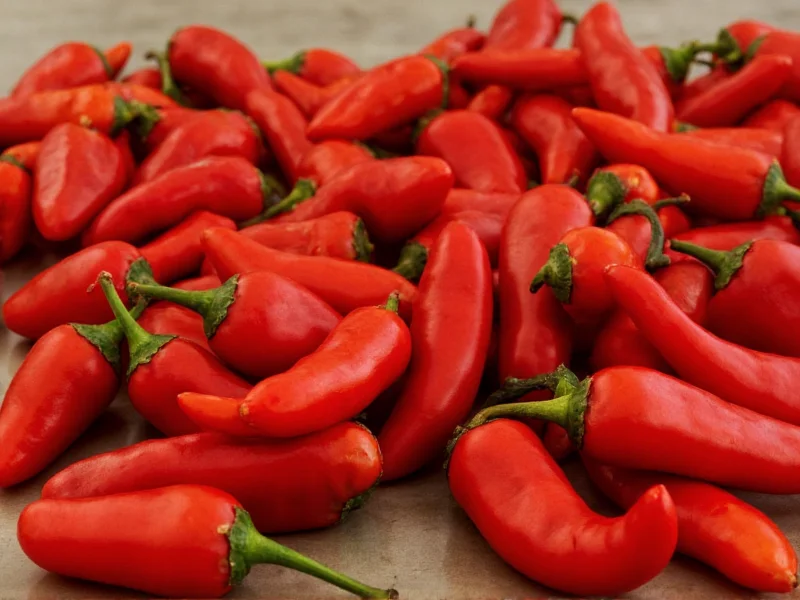Cayenne pepper's position on the Scoville scale provides valuable context for cooks, food enthusiasts, and anyone working with spicy ingredients. Understanding these measurements helps predict how cayenne will perform in recipes compared to other chili varieties. The Scoville scale, developed by pharmacist Wilbur Scoville in 1912, remains the standard measurement for chili pepper heat intensity despite newer laboratory methods like high-performance liquid chromatography (HPLC) providing more precise capsaicin quantification.
Understanding Cayenne's Heat Range
The 30,000-50,000 SHU range for cayenne pepper isn't arbitrary—it reflects natural variation influenced by growing conditions, soil composition, climate, and specific cultivar. For example:
- Drier growing conditions typically produce hotter peppers
- Stress factors like limited water can increase capsaicin production
- Different cayenne varieties exist with varying heat profiles
When comparing cayenne pepper scoville units range to other common peppers, the context becomes clearer. A standard jalapeño (2,500-8,000 SHU) is significantly milder, while the habanero (100,000-350,000 SHU) delivers substantially more heat. This understanding of scoville scale measurement for cayenne helps prevent recipe disasters and ensures proper heat balancing in culinary applications.
Practical Implications of Cayenne's Heat Level
Knowing how hot is cayenne pepper compared to jalapeno (approximately 6-20 times hotter) informs practical kitchen decisions. The heat from cayenne develops more gradually than some hotter peppers but persists longer. Unlike habaneros that deliver immediate, intense heat, cayenne provides a building warmth that integrates well into sauces, rubs, and spice blends.
Culinary professionals rely on understanding cayenne pepper spiciness measurement when substituting peppers in recipes. For those sensitive to capsaicin, even small amounts of cayenne can significantly impact a dish's heat profile. When handling fresh cayenne peppers, wearing gloves prevents capsaicin transfer to sensitive areas like eyes—a practical consideration often overlooked by novice cooks.
| Pepper Variety | Scoville Heat Units (SHU) | Heat Comparison to Cayenne |
|---|---|---|
| Bell Pepper | 0 SHU | Not spicy |
| Jalapeño | 2,500-8,000 SHU | 6-20x milder than cayenne |
| Cayenne | 30,000-50,000 SHU | Reference point |
| Tabasco | 30,000-50,000 SHU | Similar heat level |
| Habanero | 100,000-350,000 SHU | 2-11x hotter than cayenne |
| Ghost Pepper | 855,000-1,041,427 SHU | 17-35x hotter than cayenne |
Factors Affecting Cayenne's Heat Measurement
The scoville rating of cayenne pepper isn't fixed due to several variables. The placenta (white ribs inside the pepper) contains the highest concentration of capsaicin, so seeds and ribs removed will reduce overall heat. Processing methods also affect perceived heat—dried cayenne powder often tests hotter than fresh peppers due to concentration of capsaicinoids during dehydration.
Modern laboratories have largely replaced the original Scoville Organoleptic Test (which relied on human tasters diluting pepper extract until heat was undetectable) with HPLC testing. This scientific approach provides more consistent scoville scale measurement for cayenne and other peppers, though results are still converted to Scoville units for consumer understanding.
Culinary Applications and Safety Considerations
Cayenne's position on the cayenne pepper heat level chart makes it versatile for various culinary applications. Its heat integrates well into dishes without overwhelming other flavors, unlike some extremely hot peppers. When substituting cayenne in recipes, remember that 1/4 teaspoon of cayenne powder generally equals one fresh cayenne pepper.
Safety precautions matter when working with cayenne at 30,000-50,000 SHU. Always wash hands thoroughly after handling, avoid touching face or eyes, and consider wearing gloves when processing large quantities. If accidental contact occurs, dairy products like milk or yogurt provide relief by binding to capsaicin molecules better than water.
FAQ
What is the exact Scoville rating for cayenne pepper?
Cayenne pepper typically measures between 30,000 and 50,000 Scoville Heat Units (SHU). This range accounts for natural variations due to growing conditions, specific cultivar, and agricultural practices. Some exceptionally hot cayenne varieties may reach up to 70,000 SHU, while milder versions might test as low as 25,000 SHU.
How does cayenne compare to other common peppers on the Scoville scale?
Cayenne (30,000-50,000 SHU) is approximately 6-20 times hotter than a jalapeño (2,500-8,000 SHU), similar in heat to Tabasco peppers, but significantly milder than habaneros (100,000-350,000 SHU). It's about 17-35 times milder than ghost peppers. This understanding of scoville scale measurement for cayenne helps with proper recipe substitutions and heat management.
Why does cayenne pepper's Scoville rating vary so much?
Cayenne's heat level varies due to multiple factors including climate conditions, soil composition, water availability during growth, and specific genetic variety. Stressors like limited water can increase capsaicin production, making peppers hotter. The concentration of capsaicin is highest in the placenta (white ribs) and seeds, so preparation methods also affect perceived heat.
Is cayenne pepper considered hot on the Scoville scale?
On the Scoville scale, cayenne pepper falls in the medium-to-hot range (30,000-50,000 SHU). While significantly hotter than common peppers like jalapeños, it's much milder than extreme heat peppers like ghost peppers or Carolina reapers. Most culinary professionals consider cayenne to provide substantial heat that's manageable in cooking without being overwhelming.
How can I safely handle cayenne pepper given its heat level?
When handling cayenne peppers, wear gloves to prevent capsaicin transfer to sensitive areas. Always wash hands thoroughly with soap after handling, even if wearing gloves. Avoid touching your face, especially eyes. If accidental contact occurs, use dairy products like milk or yogurt rather than water for relief, as capsaicin is fat-soluble. Work in a well-ventilated area as dried cayenne powder can become airborne.











 浙公网安备
33010002000092号
浙公网安备
33010002000092号 浙B2-20120091-4
浙B2-20120091-4